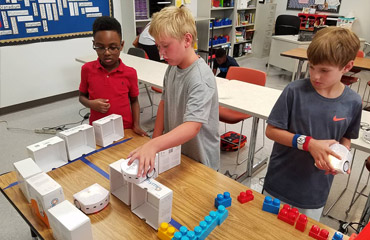Students develop increasingly complex coding skills and apply them to a project-based learning capstone.
Students integrate increasingly complex logic into their coding projects by creating a state machine that enables Thymio to respond to similar inputs in multiple ways within the same program. Students learn to access Thymio’s onboard accelerometer, and to develop code which allows Thymio to respond to changes in physical orientation. Students work independently to develop customized projects, and take greater responsibility for debugging their code. Students apply their coding tools to a final project, programming Thymio to act as a mobile “barcode” scanner which acts out a different behavior sequence depending upon the visual input each barcode provides.



